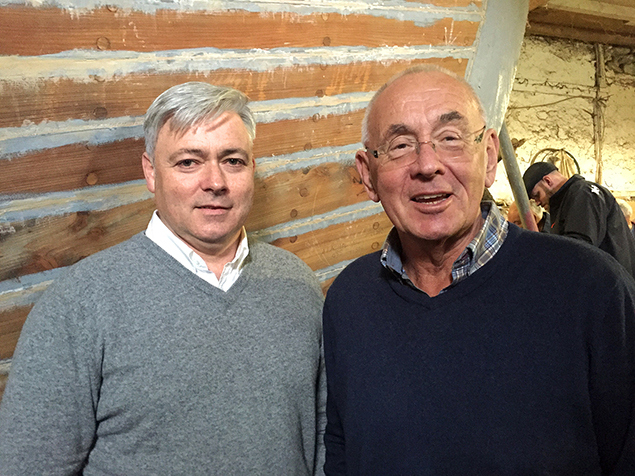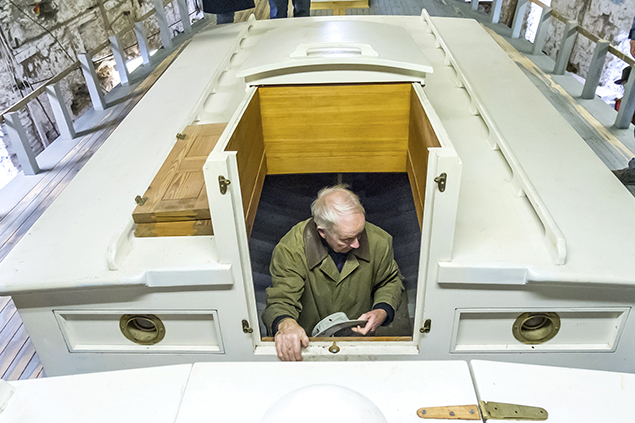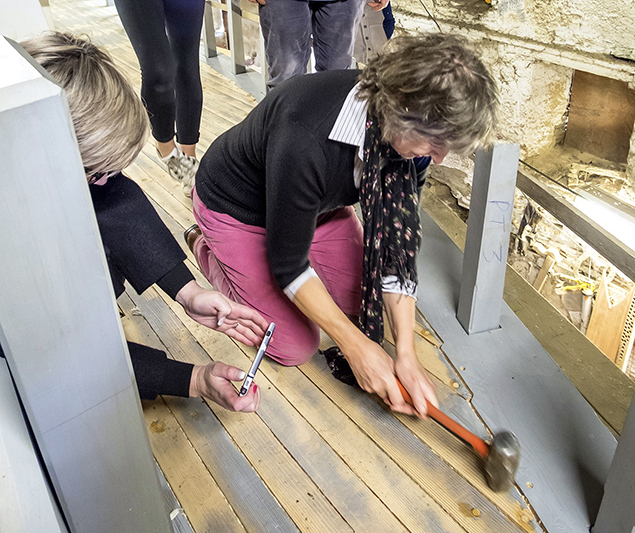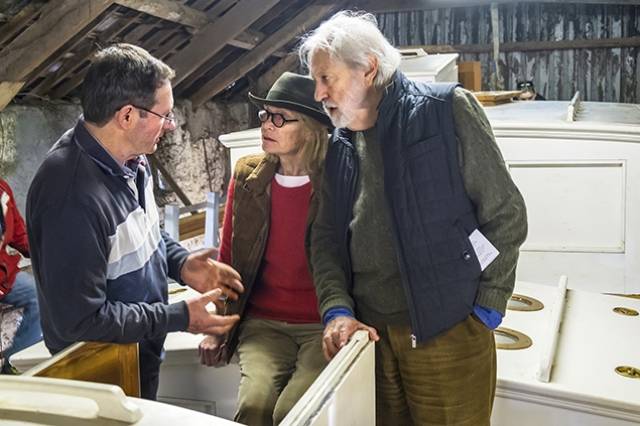The restoration of the 57–ft traditional multi-cargo ketch Ilen, built in Baltimore in 1926, has taken a significant step forward through the formal closing of her deck with the ceremonial fastening home of the final plank at Liam Hegarty’s boatyard at Oldcourt beside the River Ilen.
The ceremony, hosted on Saturday by the Ilen Project, Limerick, marked a significant milestone in a re-build project whose primary goal is to bring Ireland’s sole surviving wooden sailing ship back to Limerick. It was Limerick man Conor O’Brien of Foynes Island who secured the order for the Ilen when he called by the Falkland Islands after rounding Cape Horn in 1925 in his world-girdling 40ft Baltimore-built Saoirse. The islanders decided that a larger version of Saoirse would provide an ideal inter-island communication, transport and ferry vessel for their rugged archipelago, and within two years Conor O’Brien had returned with the Ilen to fulfill their commission.
 American shipwright Matt Dirr, one of the many international talents who has contributed his skills to the Ilen project, does some final tidying-up before the ceremony.
American shipwright Matt Dirr, one of the many international talents who has contributed his skills to the Ilen project, does some final tidying-up before the ceremony.
Saturday’s very special occasion revealed the beauty of the vessel to all those who attended - the high quality materials, the exemplary craftsmanship, and most significantly the marine educational role the vessel can be expected to play when she takes up her operational life on the Shannon Estuary and beyond, from her new home port of Limerick.
Brother Anthony Keane of Glenstal Abbey, a key promoter of the Ilen Project, officiated at the ceremony and said that what has been achieved so far showed that there was not alone a great work ethic in the Ilen Project but also a spiritual commitment to the work being done. "This is an amazing act of faith and commitment come to fruition. This boat, and the people involved with it, rock. It is heading for the sea, like a salmon, and it will not be stopped, even if some of the financial people have still to solve their problems of calculus and apply their mathematics. The faith, energy and skill of Liam Hegarty, John Hegarty, Fachtna O’Sullivan, and their team at Hegarty’s Boatyard are sufficient to tell a tree to be uprooted and launched into the sea, and see it happen. Their work is a phenomenon which outside administrators might better observe and study rather than direct or control.”
 Brother Anthony Keane of Glenstal Abbey has been a key promoter of the Iken Project since its inception, and spoke with enthusiasm of all that it meant to those involved and to Limerick generally.
Brother Anthony Keane of Glenstal Abbey has been a key promoter of the Iken Project since its inception, and spoke with enthusiasm of all that it meant to those involved and to Limerick generally.
Ceremony guest speaker Lord David Puttnam said that "the project underlined what could be done by a determined community, a community that could make their decisions for themselves, not to be dependent upon others beyond their community, but to be self-sufficient, and the project of the Ilen showed that. It also demonstrated that the skills involved, and which were being taught, were skills which younger people could learn, use and remain in their community, without having to leave, and thus strengthen communities. This is a message from the Ilen project."
 The supporters of the Ilen Project come from a wide range of backgrounds – this is Gary MacMahon, a director of the Ilen Boat-building School, with former Irish Cruising Club Commodore David Tucker of Kinsale.
The supporters of the Ilen Project come from a wide range of backgrounds – this is Gary MacMahon, a director of the Ilen Boat-building School, with former Irish Cruising Club Commodore David Tucker of Kinsale.
Dr Edward Walsh, founding president of the University of Limerick, also spoke, and told of how he had at the outset of the project exhorted all to simply “go ahead and buy the boat” and “pretend” that the money was there, and it was a source of great pride for him to see how it had advanced so far.
The good ship Ilen has advanced to this moment in time where she happily accepts this final plank. It has been a long journey, an arduous journey, which continues, but one which has reached a plateau, a place and time of wonder and of thanks.
In 1926 the Ilen, Ireland’s sole surviving wooden sailing ship, sailed from Limerick to an active 70 year working life in the South Atlantic, and the completion last Saturday of her new weather deck brings her return to seafaring a lot closer.
 Dr Edward Walsh has a look-see down below. The founder of Limerick University encouraged the project from the start with his initial advice of “go head and buy the boat”, and since then funds have been raised from a wide variety of sources to keep the show on the road.
Dr Edward Walsh has a look-see down below. The founder of Limerick University encouraged the project from the start with his initial advice of “go head and buy the boat”, and since then funds have been raised from a wide variety of sources to keep the show on the road.
Saturday’s decking-out ceremony afforded all those who attended the unique opportunity to view the classic lines of the vessel, feel the reel of the heaving keel, admire her sheer, walk the new old growth Douglas Fir deck, or stand below deck amid her massive Irish oak frames - a tactile experiences unique to big wooden sailing ships.
And so Sinead Hegarty and Mary Jordan of Baltimore, hammered home the final deck plank with blows swift, sweet and true. The ship seemed imperceptibly to roll a little, looking forward to her sea trials.
 Job done. Mary Jordan of Baltimore drives home the final deck fastening. All photos Kevin O’Farrell, Baltimore
Job done. Mary Jordan of Baltimore drives home the final deck fastening. All photos Kevin O’Farrell, Baltimore






























































